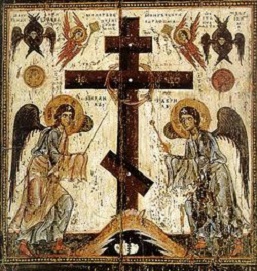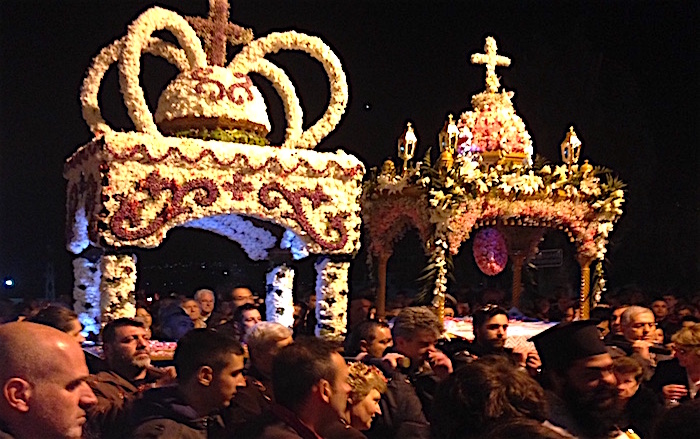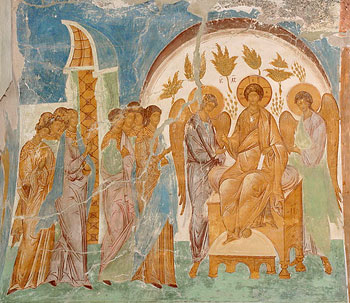Theology
The Dormition Fast
14. August 2016 - 12:06
 The Dormition fast was established as preceding the great feasts of the Transfiguration of the Lord and of the Dormition of the Mother of God. It lasts two weeks—from August 1/14–August 14/27 (old style/new style).
The Dormition fast was established as preceding the great feasts of the Transfiguration of the Lord and of the Dormition of the Mother of God. It lasts two weeks—from August 1/14–August 14/27 (old style/new style).
The Dormition fast comes down to us from the early days of Christianity.We find a clear reference to the Dormition fast in a conversation of Leo the Great from around the year 450 A.D. “The Church fasts are situated in the year in such a way that a special abstinence is prescribed for each time. Thus, for spring there is the spring fast ]—the Forty Days[Great Lent; for summer there is the summer fast… [the Apostles’ fast]; for autumn there is the autumn fast, in the seventh month [Dormition fast]; for winter there is the winter fast [Nativity fast].”
Icon of the Mother of God of Three Hands
25. July 2016 - 9:43 Commemorated on June 28
Commemorated on June 28
In the ninth century during the time of the Iconoclasts, St. John of Damascus was zealous in his veneration of the holy icons. Because of this, he was slandered by the emperor and iconoclast Leo III who informed the Damascus caliph that St. John was committing treasonous acts. The caliph gave orders to cut off the hand of the monk and take it to the marketplace. That evening St. John, having asked the caliph for the cut-off hand, put it to its joint and fell to the ground before the icon of the Mother of God. The monk begged Our Lady to heal his hand, which had written in defense of Orthodoxy. After praying he fell asleep and saw in a dream that the All-Pure Mother of God had turned to him promising him quick healing.
Pre-Conciliar Document: "Autonomy and the Means of Proclaiming It"
17. May 2016 - 9:26Decision taken by the 5th Pan-Orthodox Pre-Council Conference, Chambésy, October 10-17, 2015
Published in compliance with the resolution of the Synaxis of the Primates of Local Orthodox Churches, Chambésy, January 21-28, 2016.
Upon completing the work based on the text "Autonomy and the Means of Proclaiming It" that had been agreed upon and adopted by the Inter-Orthodox Preparatory Commission at its session in Chambésy on December 9-17, 2009, the 5th Pan-Orthodox Pre -Council Conference considered ecclesiological, canonical and pastoral aspects of the institution of autonomy and arrived at a unanimous Pan-Orthodox position on the matter.
Good Friday: Greek Orthodox Traditions of the Epitaph
29. April 2016 - 18:13
Good Friday is an eminently mournful day commemorating the Passion of the Christ across Greece. Even the most remote churches honor the tradition of the epitaph, filling the atmosphere with piety and devoutness.
Synaxarion: Holy and Great Tuesday
26. April 2016 - 12:07 On Holy and Great Tuesday, we commemorate the parable of the ten virgins, because the Lord related this parable to His disciples as He was going toward Jerusalem to His Holy Passion.
On Holy and Great Tuesday, we commemorate the parable of the ten virgins, because the Lord related this parable to His disciples as He was going toward Jerusalem to His Holy Passion.
He told the parable of the ten virgins to call attention to almsgiving, at the same time teaching that every man must be ready before the end comes. He had spoken many times to them about chastity. Virginity is held in great honor, because it is indeed a great thing. Yet, lest anyone, while practicing this one virtue, neglect the others, and particularly love, by which the lamp of virginity is given light, he will be put to shame by the Lord. The Holy Gospel introduces this parable, calling five of the virgins wise, because they represent readiness to practice both love and virginity, and five of them foolish because, though they had virginity, they did not have love commensurate with it. They are foolish, therefore, because they practiced a great virtue yet neglected one that is easier and were reckoned as being no better than harlots; the latter were defeated by bodily pleasures, whereas the former, by possessions.
Holy Week: An Explanation
26. April 2016 - 10:55 Great Lent and Holy Week are two separate fasts, and two separate celebrations. Great Lent ends on Friday of the fifth week (the day before Lazarus Saturday). Holy Week begins immediately thereafter. Let's explore the meaning of each of the solemn days of Passion Week.
Great Lent and Holy Week are two separate fasts, and two separate celebrations. Great Lent ends on Friday of the fifth week (the day before Lazarus Saturday). Holy Week begins immediately thereafter. Let's explore the meaning of each of the solemn days of Passion Week.
Lazarus Saturday: Lazarus Saturday is the day which begins Holy Week. It commemorates the raising of our Lord's friend Lazarus, who had been in the tomb four days. This act confirmed the universal resurrection from the dead that all of us will experience at our Lord's Second Coming. This miracle led many to faith, but it also led to the chief priest's and Pharisees' decision to kill Jesus (John 11:47-57).
Palm Sunday (The Entrance of our Lord into Jerusalem): Our Lord enters Jerusalem and is proclaimed king - but in an earthly sense, as many people of His time were seeking a political Messiah. Our Lord is King, of course, but of a different type - the eternal King prophesied by Zechariah the Prophet. We use palms on this day to show that we too accept Jesus as the true King and Messiah of the Jews, Who we are willing to follow - even to the cross.
Holy Monday, Tuesday and Wednesday: The first thing that must be said about these services, and most of the other services of Holy Week, is that they are "sung" in anticipation. Each service is rotated ahead twelve hours. The evening service, therefore, is actually the service of the next morning, while the morning services of Holy Thursday and Holy Saturday are actually the services of the coming evening.

